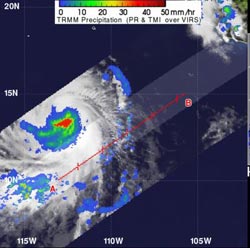NASA's TRMM Satellite sees heavy rainfall in Tropical Storm Daniel's center

The TRMM satellite passed over Tropical Storm Daniel on July 6, 2012, at 0034 UTC and data revealed heavy rain falling around the southern periphery of the center of circulation. The heavy rain (in red) was falling at a rate of more than 2 inches/50 mm per hour. The yellow, green and blue areas indicate light-to-moderate rainfall between 20 and 40 millimeters (.78 to 1.57 inches) per hour. Credit: SSAI/NASA, Hal Pierce<br>
When the Tropical Rainfall Measuring Mission (TRMM) satellite passed over Tropical Storm Daniel on July 6, 2012 at 0034 UTC, data revealed heavy rain falling around the southern periphery of the center of circulation.
The heavy rain was falling at a rate of more than 2 inches/50 mm per hour. TRMM is jointly managed by both NASA and the Japanese Space Agency, JAXA.
Daniel remains no threat to land, however, as the storm is expected to continue on a westward track into the open waters of the eastern Pacific over the weekend.
At 5 a.m. EDT (2 a.m. PDT) on Friday, July 6, 2012, Daniel was far from land. Its center was located about 640 miles (1030 kilometers) south-southwest of the southern tip of Baja California, near 14.6 North and 114.2 West.
Daniel's maximum sustained winds increased to 65 mph (100 kmh) and the tropical storm is moving west at 14 mph (22 kmh). The National Hurricane Center expects Daniel to continue moving in this direction over the weekend.
Media Contact
More Information:
http://www.nasa.govAll latest news from the category: Earth Sciences
Earth Sciences (also referred to as Geosciences), which deals with basic issues surrounding our planet, plays a vital role in the area of energy and raw materials supply.
Earth Sciences comprises subjects such as geology, geography, geological informatics, paleontology, mineralogy, petrography, crystallography, geophysics, geodesy, glaciology, cartography, photogrammetry, meteorology and seismology, early-warning systems, earthquake research and polar research.
Newest articles

High-energy-density aqueous battery based on halogen multi-electron transfer
Traditional non-aqueous lithium-ion batteries have a high energy density, but their safety is compromised due to the flammable organic electrolytes they utilize. Aqueous batteries use water as the solvent for…

First-ever combined heart pump and pig kidney transplant
…gives new hope to patient with terminal illness. Surgeons at NYU Langone Health performed the first-ever combined mechanical heart pump and gene-edited pig kidney transplant surgery in a 54-year-old woman…

Biophysics: Testing how well biomarkers work
LMU researchers have developed a method to determine how reliably target proteins can be labeled using super-resolution fluorescence microscopy. Modern microscopy techniques make it possible to examine the inner workings…





















